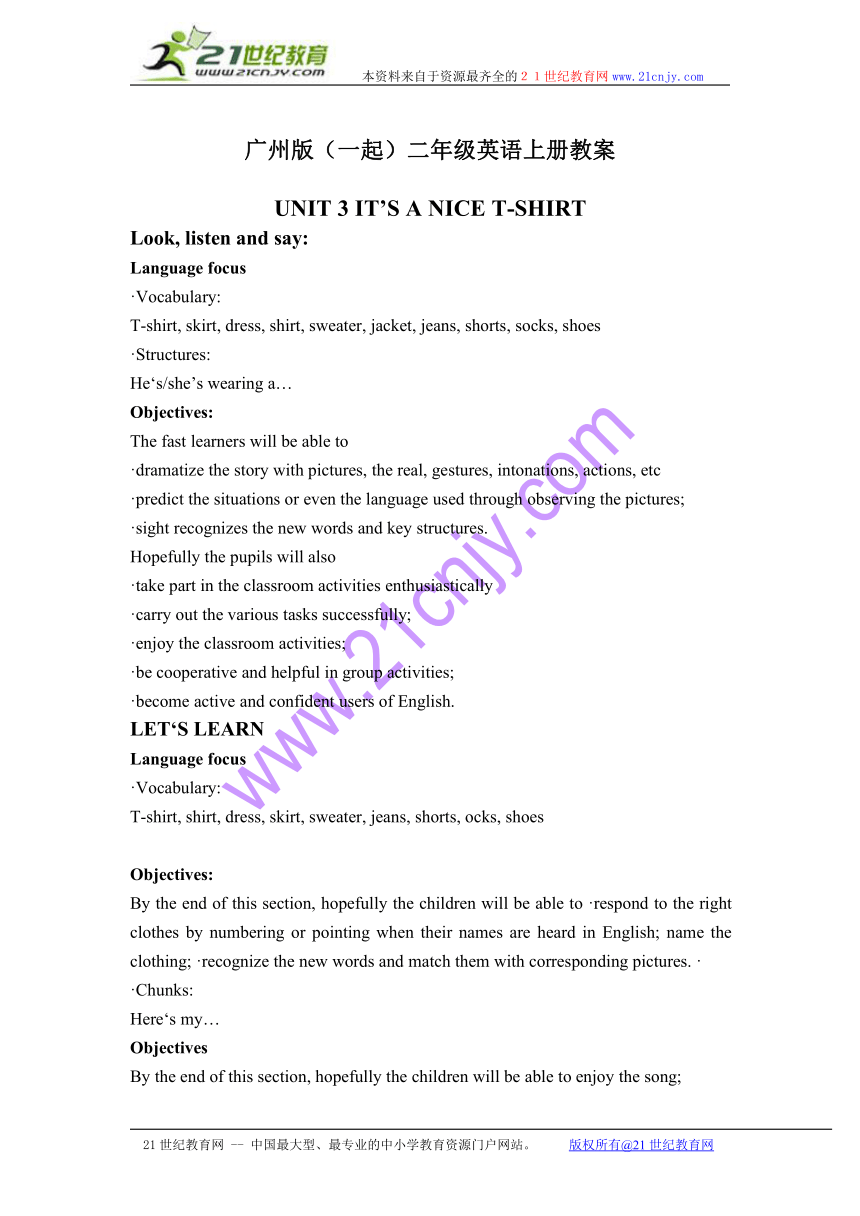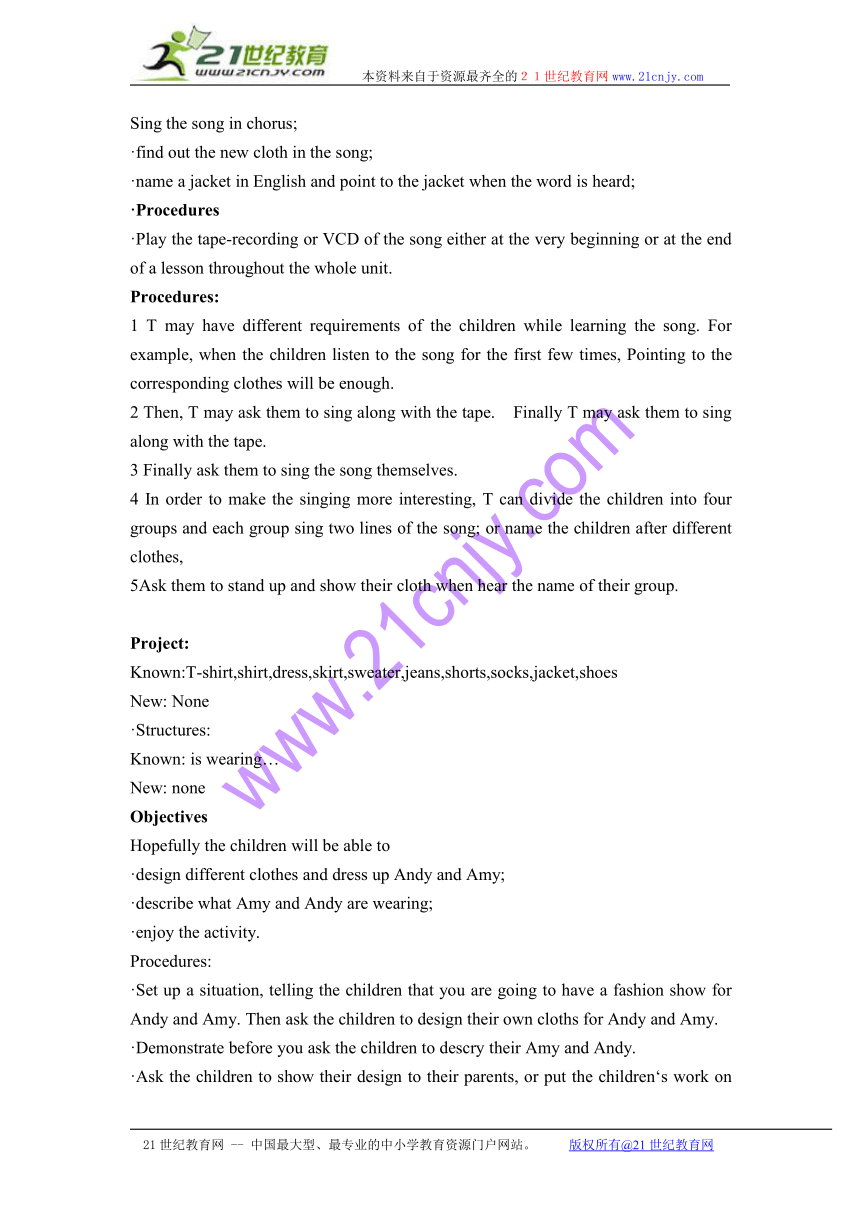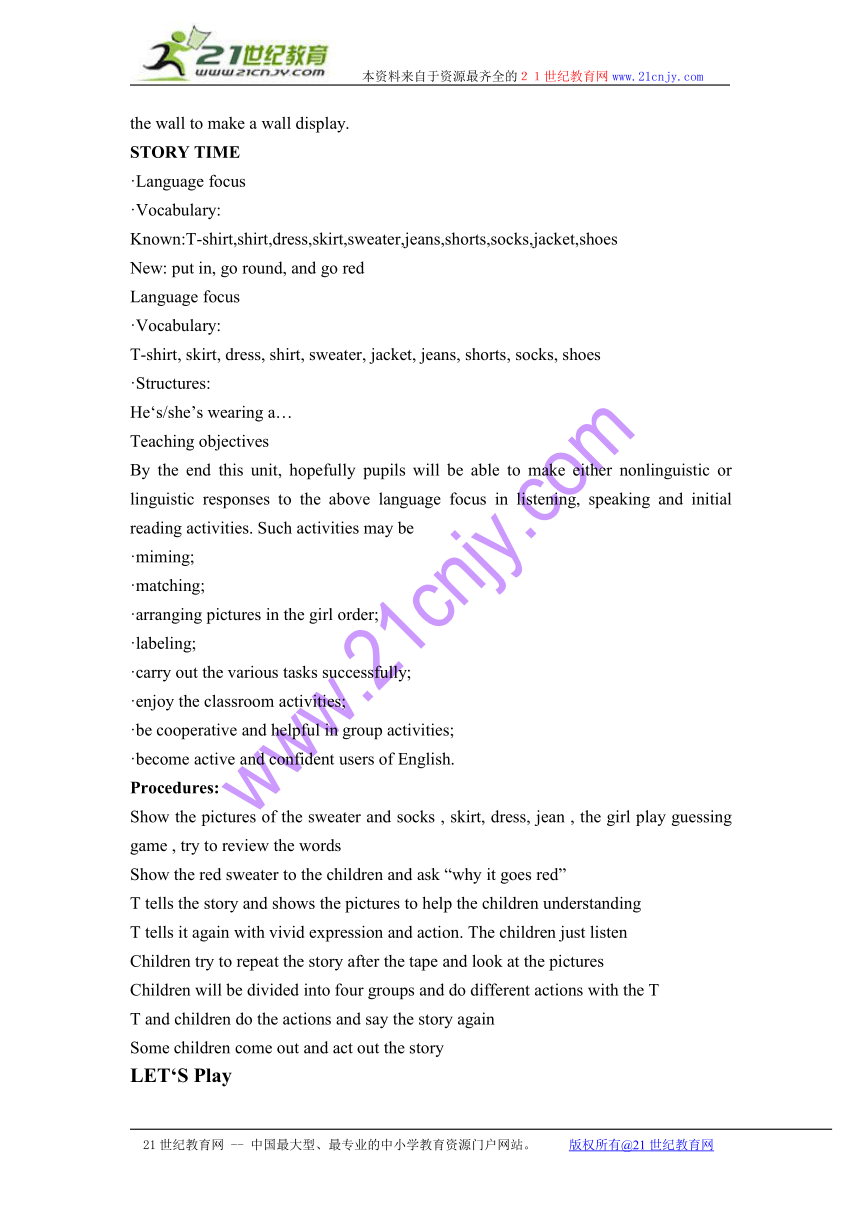广州版(一起)二年级英语上册教案 unit 3(1)
文档属性
| 名称 | 广州版(一起)二年级英语上册教案 unit 3(1) |  | |
| 格式 | rar | ||
| 文件大小 | 14.0KB | ||
| 资源类型 | 教案 | ||
| 版本资源 | 其它版本 | ||
| 科目 | 英语 | ||
| 更新时间 | 2010-01-12 12:59:00 | ||
图片预览



文档简介
本资料来自于资源最齐全的21世纪教育网www.21cnjy.com
广州版(一起)二年级英语上册教案
UNIT 3 IT’S A NICE T-SHIRT
Look, listen and say:
Language focus
·Vocabulary:
T-shirt, skirt, dress, shirt, sweater, jacket, jeans, shorts, socks, shoes
·Structures:
He‘s/she’s wearing a…
Objectives:
The fast learners will be able to
·dramatize the story with pictures, the real, gestures, intonations, actions, etc
·predict the situations or even the language used through observing the pictures;
·sight recognizes the new words and key structures.
Hopefully the pupils will also
·take part in the classroom activities enthusiastically
·carry out the various tasks successfully;
·enjoy the classroom activities;
·be cooperative and helpful in group activities;
·become active and confident users of English.
LET‘S LEARN
Language focus
·Vocabulary:
T-shirt, shirt, dress, skirt, sweater, jeans, shorts, ocks, shoes
Objectives:
By the end of this section, hopefully the children will be able to ·respond to the right clothes by numbering or pointing when their names are heard in English; name the clothing; ·recognize the new words and match them with corresponding pictures. ·
·Chunks:
Here‘s my…
Objectives
By the end of this section, hopefully the children will be able to enjoy the song;
Sing the song in chorus;
·find out the new cloth in the song;
·name a jacket in English and point to the jacket when the word is heard;
·Procedures
·Play the tape-recording or VCD of the song either at the very beginning or at the end of a lesson throughout the whole unit.
Procedures:
1 T may have different requirements of the children while learning the song. For example, when the children listen to the song for the first few times, Pointing to the corresponding clothes will be enough.
2 Then, T may ask them to sing along with the tape. Finally T may ask them to sing along with the tape.
3 Finally ask them to sing the song themselves.
4 In order to make the singing more interesting, T can divide the children into four groups and each group sing two lines of the song; or name the children after different clothes,
5Ask them to stand up and show their cloth when hear the name of their group.
Project:
Known:T-shirt,shirt,dress,skirt,sweater,jeans,shorts,socks,jacket,shoes
New: None
·Structures:
Known: is wearing…
New: none
Objectives
Hopefully the children will be able to
·design different clothes and dress up Andy and Amy;
·describe what Amy and Andy are wearing;
·enjoy the activity.
Procedures:
·Set up a situation, telling the children that you are going to have a fashion show for Andy and Amy. Then ask the children to design their own cloths for Andy and Amy.
·Demonstrate before you ask the children to descry their Amy and Andy.
·Ask the children to show their design to their parents, or put the children‘s work on the wall to make a wall display.
STORY TIME
·Language focus
·Vocabulary:
Known:T-shirt,shirt,dress,skirt,sweater,jeans,shorts,socks,jacket,shoes
New: put in, go round, and go red
Language focus
·Vocabulary:
T-shirt, skirt, dress, shirt, sweater, jacket, jeans, shorts, socks, shoes
·Structures:
He‘s/she’s wearing a…
Teaching objectives
By the end this unit, hopefully pupils will be able to make either nonlinguistic or linguistic responses to the above language focus in listening, speaking and initial reading activities. Such activities may be
·miming;
·matching;
·arranging pictures in the girl order;
·labeling;
·carry out the various tasks successfully;
·enjoy the classroom activities;
·be cooperative and helpful in group activities;
·become active and confident users of English.
Procedures:
Show the pictures of the sweater and socks , skirt, dress, jean , the girl play guessing game , try to review the words
Show the red sweater to the children and ask “why it goes red”
T tells the story and shows the pictures to help the children understanding
T tells it again with vivid expression and action. The children just listen
Children try to repeat the story after the tape and look at the pictures
Children will be divided into four groups and do different actions with the T
T and children do the actions and say the story again
Some children come out and act out the story
LET‘S Play
Language focus
·Vocabulary:
T-shirt, shirt, dress, skirt, sweater, jeans, shorts, socks, shoes
·Structures: None
Objectives
By the end of this section, hopefully the children will be able to
·respond to the right clothes by numbering or pointing when their names are heard in English;
·name the clothing;
·recognize the new words and match them with corresponding pictures
·Structures:
None
·Chunks:
Here‘s my…
Objectives
By the end of this section, hopefully the children will be able to
·enjoy the song;
·sing the song in chorus;
·find out the new cloth in the song;
·name a jacket in English and point to the jacket when the word is heard;
·Procedures
·Play the tape-recording or VCD of the song either at the very beginning or at the end of a lesson throughout the whole unit.
·Different requirements of the children while learning the For example, when the children dialogue, listen to T for the first few times, Pointing to the corresponding clothes will be enough. Then, ask them to say along, with the tape. Finally ask them to read along with the tape.
.T gives the demo for the children how to play the game
Children play the games in pairs
Listen, say and chant
·Konown:T-shirt,shirt,dress,skirt,sweater,jeans,shorts,socks,jacket,shoes
New: None
·Structures: on the ---,
New: none
Objectives
Hopefully the children will be able to
·design different clothes
·enjoy the activity.
Procedures:
·Set up a situation with the pictures, teach the new ones
Tell the children that you are going to say a chant for them.
Beat the rhythm with hands and say the chant, children do the actions
·Demonstrate before you ask the children to say the chant
·Ask the children to show their chant to their parents,
.The dialogues in LET“S TALK usually takes place in the kitchen at home and the canteen at school. To set up the situations, we‘d better divide the classroom into two areas and decorate them as the kitchen and the canteen.
Thus, the children can play different roles and make the dialogues in nearly real situations.
The life like situations in this section implies that you need to dramatize your presentation of the dialogue, so do the children when they act out the dialogue. An example may be to frown when you say “Oh no! Noodles again. I don‘t like noodles."
STORY TIME.
Language focus
.Vocabulary:
Known: chicken, sausage, fish, bread
New: mouse
.Structures: none
Chunks: I‘m hungry.
I‘m full.
You are dead.
Objectives
Hopefully the children will
.enjoy reading and listening to the story and be able to act it out.
Procedures:
The plot of the story is very interesting and the language is simple enough for the children to understand. Since the children have an instinct of going for meaning, we‘d better provide them opportunities to go straight for the meaning. Before telling the story, we can ask the children to look at the series of pictures in the story and guess the plot of the story. Then encourage them to express their imagination either in Chinese or in English. While listening to the story, the children may have chances to predict what‘s happening. By the end of the story, they can discuss what will happen to the mouse. .The chunks in the story are frequently used in the daily life. Furthermore, the children have learnt some of them for several times, e. g. I am hungry. You bad mouse. Etc. So, though these daily expressions are not the language
focus of the unit, the children (esp. the fast learners) are encouraged to say and use them orally.
21世纪教育网 -- 中国最大型、最专业的中小学教育资源门户网站。 版权所有@21世纪教育网
广州版(一起)二年级英语上册教案
UNIT 3 IT’S A NICE T-SHIRT
Look, listen and say:
Language focus
·Vocabulary:
T-shirt, skirt, dress, shirt, sweater, jacket, jeans, shorts, socks, shoes
·Structures:
He‘s/she’s wearing a…
Objectives:
The fast learners will be able to
·dramatize the story with pictures, the real, gestures, intonations, actions, etc
·predict the situations or even the language used through observing the pictures;
·sight recognizes the new words and key structures.
Hopefully the pupils will also
·take part in the classroom activities enthusiastically
·carry out the various tasks successfully;
·enjoy the classroom activities;
·be cooperative and helpful in group activities;
·become active and confident users of English.
LET‘S LEARN
Language focus
·Vocabulary:
T-shirt, shirt, dress, skirt, sweater, jeans, shorts, ocks, shoes
Objectives:
By the end of this section, hopefully the children will be able to ·respond to the right clothes by numbering or pointing when their names are heard in English; name the clothing; ·recognize the new words and match them with corresponding pictures. ·
·Chunks:
Here‘s my…
Objectives
By the end of this section, hopefully the children will be able to enjoy the song;
Sing the song in chorus;
·find out the new cloth in the song;
·name a jacket in English and point to the jacket when the word is heard;
·Procedures
·Play the tape-recording or VCD of the song either at the very beginning or at the end of a lesson throughout the whole unit.
Procedures:
1 T may have different requirements of the children while learning the song. For example, when the children listen to the song for the first few times, Pointing to the corresponding clothes will be enough.
2 Then, T may ask them to sing along with the tape. Finally T may ask them to sing along with the tape.
3 Finally ask them to sing the song themselves.
4 In order to make the singing more interesting, T can divide the children into four groups and each group sing two lines of the song; or name the children after different clothes,
5Ask them to stand up and show their cloth when hear the name of their group.
Project:
Known:T-shirt,shirt,dress,skirt,sweater,jeans,shorts,socks,jacket,shoes
New: None
·Structures:
Known: is wearing…
New: none
Objectives
Hopefully the children will be able to
·design different clothes and dress up Andy and Amy;
·describe what Amy and Andy are wearing;
·enjoy the activity.
Procedures:
·Set up a situation, telling the children that you are going to have a fashion show for Andy and Amy. Then ask the children to design their own cloths for Andy and Amy.
·Demonstrate before you ask the children to descry their Amy and Andy.
·Ask the children to show their design to their parents, or put the children‘s work on the wall to make a wall display.
STORY TIME
·Language focus
·Vocabulary:
Known:T-shirt,shirt,dress,skirt,sweater,jeans,shorts,socks,jacket,shoes
New: put in, go round, and go red
Language focus
·Vocabulary:
T-shirt, skirt, dress, shirt, sweater, jacket, jeans, shorts, socks, shoes
·Structures:
He‘s/she’s wearing a…
Teaching objectives
By the end this unit, hopefully pupils will be able to make either nonlinguistic or linguistic responses to the above language focus in listening, speaking and initial reading activities. Such activities may be
·miming;
·matching;
·arranging pictures in the girl order;
·labeling;
·carry out the various tasks successfully;
·enjoy the classroom activities;
·be cooperative and helpful in group activities;
·become active and confident users of English.
Procedures:
Show the pictures of the sweater and socks , skirt, dress, jean , the girl play guessing game , try to review the words
Show the red sweater to the children and ask “why it goes red”
T tells the story and shows the pictures to help the children understanding
T tells it again with vivid expression and action. The children just listen
Children try to repeat the story after the tape and look at the pictures
Children will be divided into four groups and do different actions with the T
T and children do the actions and say the story again
Some children come out and act out the story
LET‘S Play
Language focus
·Vocabulary:
T-shirt, shirt, dress, skirt, sweater, jeans, shorts, socks, shoes
·Structures: None
Objectives
By the end of this section, hopefully the children will be able to
·respond to the right clothes by numbering or pointing when their names are heard in English;
·name the clothing;
·recognize the new words and match them with corresponding pictures
·Structures:
None
·Chunks:
Here‘s my…
Objectives
By the end of this section, hopefully the children will be able to
·enjoy the song;
·sing the song in chorus;
·find out the new cloth in the song;
·name a jacket in English and point to the jacket when the word is heard;
·Procedures
·Play the tape-recording or VCD of the song either at the very beginning or at the end of a lesson throughout the whole unit.
·Different requirements of the children while learning the For example, when the children dialogue, listen to T for the first few times, Pointing to the corresponding clothes will be enough. Then, ask them to say along, with the tape. Finally ask them to read along with the tape.
.T gives the demo for the children how to play the game
Children play the games in pairs
Listen, say and chant
·Konown:T-shirt,shirt,dress,skirt,sweater,jeans,shorts,socks,jacket,shoes
New: None
·Structures: on the ---,
New: none
Objectives
Hopefully the children will be able to
·design different clothes
·enjoy the activity.
Procedures:
·Set up a situation with the pictures, teach the new ones
Tell the children that you are going to say a chant for them.
Beat the rhythm with hands and say the chant, children do the actions
·Demonstrate before you ask the children to say the chant
·Ask the children to show their chant to their parents,
.The dialogues in LET“S TALK usually takes place in the kitchen at home and the canteen at school. To set up the situations, we‘d better divide the classroom into two areas and decorate them as the kitchen and the canteen.
Thus, the children can play different roles and make the dialogues in nearly real situations.
The life like situations in this section implies that you need to dramatize your presentation of the dialogue, so do the children when they act out the dialogue. An example may be to frown when you say “Oh no! Noodles again. I don‘t like noodles."
STORY TIME.
Language focus
.Vocabulary:
Known: chicken, sausage, fish, bread
New: mouse
.Structures: none
Chunks: I‘m hungry.
I‘m full.
You are dead.
Objectives
Hopefully the children will
.enjoy reading and listening to the story and be able to act it out.
Procedures:
The plot of the story is very interesting and the language is simple enough for the children to understand. Since the children have an instinct of going for meaning, we‘d better provide them opportunities to go straight for the meaning. Before telling the story, we can ask the children to look at the series of pictures in the story and guess the plot of the story. Then encourage them to express their imagination either in Chinese or in English. While listening to the story, the children may have chances to predict what‘s happening. By the end of the story, they can discuss what will happen to the mouse. .The chunks in the story are frequently used in the daily life. Furthermore, the children have learnt some of them for several times, e. g. I am hungry. You bad mouse. Etc. So, though these daily expressions are not the language
focus of the unit, the children (esp. the fast learners) are encouraged to say and use them orally.
21世纪教育网 -- 中国最大型、最专业的中小学教育资源门户网站。 版权所有@21世纪教育网
同课章节目录
